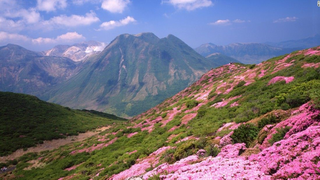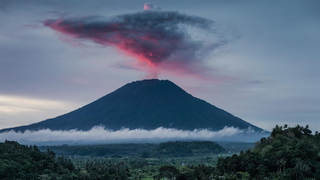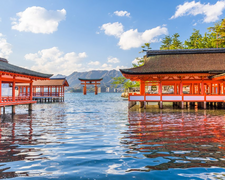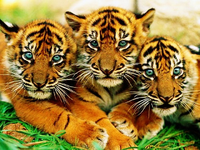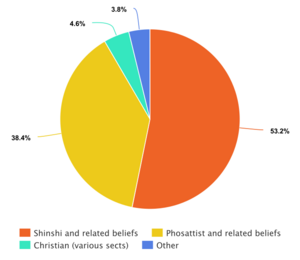Esonice
This article is incomplete because it is pending further input from participants, or it is a work-in-progress by one author. Please comment on this article's talk page to share your input, comments and questions. Note: To contribute to this article, you may need to seek help from the author(s) of this page. |
Serene Kingdom of Esonice Esonya --Esonya-- | |
|---|---|
Motto: "---" "We shall endure" | |
Anthem: "Land of Flowers" | |
| Capital and largest city | |
| Official languages | Esonian |
| Recognised national languages | Esonian |
| Recognised regional languages | Velisian, Juraban, Alodian, Hirumese, Chiyashan, Kumikan, Emisan, Yatosan |
| Religion | Secular |
| Demonym(s) | Esonian |
| Government | Federal parliamentary constitutional monarchy |
• Serene Prince | Sanomi |
• Prime Minister | Aircho |
| Legislature | TBA |
| House of the lords | |
| House of the Commons | |
| Establishment | |
| Area | |
• | 354,835 km2 (137,003 sq mi) |
• Water (%) | 4.19 |
| Population | |
• 2019 estimate | 33,753,193 |
• Density | 95/km2 (246.0/sq mi) |
| GDP (PPP) | 2020 estimate |
• Total | $1.427 trillion |
• Per capita | $42,289 |
| GDP (nominal) | 2020 estimate |
• Total | $1.270 trillion |
• Per capita | $37,623 (10th) |
| Gini (2020) | 33.6 medium |
| HDI (2020) | very high |
| Currency | Esonian Zō (Ƶ) (ESO) |
| Time zone | UTC-8 |
| Date format | dd/mm/yy |
| Driving side | left |
| Calling code | +66 |
| Internet TLD | .es |
Esonice (Esonian: Esonya) offically the Serene Kingdom of Esonice (Esonian: ---) is an island nation located in Western Alharu part of the Esonian archipelago, surrounded by the Tiauhai Sea, also known as the sea of the Moon (Esonian: Motsu no koshin) to the west, the North Oriental Ocean to the north-west, and the sea of the Rising Sun (Esonian: Motsu no ---) in the east and the Velisian straits to the north-east. Esonice is also close to the giant Paran desert on mainland Alharu, that isolates the islands from most of the Alharun continent. Esonice does not have any immediate borders on land, but on its maritime borders its neighbours are the Andallan protectorate state of Giokto to the south, the Commonwealth of Andalla to the west, and island republics of Sushindo and Vikeda in the east. Esonice has a total of 257 islands in its territories; in total covering approximately 354,835km2 with a population density of less than 100 people per square kilometre. Its 3 main islands are the islands of Hirosho, Lisharishi and Mibiveshi. Other noticeable islands include Katomei, Shimishi, Zumaishi, Korado, Nanshi and Makoshi. Esonice's geographic terrain is mixed, ranging from the fertile sub-tropics in the eastern regions, to a semi-arid coastline surrounded by a lush tropical savannah in the north-western region - with both the eastern and western portions of the Hirosho island being separated, to an extent, by the Emisan mountain range. The islands are also known as large producers of unique varieties of tea and chocolate that can only be found on them. Various gemstones can also be found on the islands, such as emeralds, tiger eye and many different quartz such as rose quartz, including rarer gems such as hauyne and kornerupine created due to the high volcanic activity present in Esonice. Many pearls can also be found present on the Esonian coasts and much of the Esonian archipelago.
TBA
Esonice is classified as a high income developed nation, home to a population of 33,753,193 inhabitants, with its most populous city being Maimedo with a population of 3,824,354 which also serves as the national capital, financial and cultural centre. Following the years after the Thalassan war, Esonice enjoyed an economic boom which lasted from the 1960s to the 1990s. Today Esonian citizens enjoy a high standard of living, alongside a free universal healthcare system, high standards of education, and economic freedom. Esonice has a vibrant cultural heritage, spanning from Esonice's renowned artistic scene, its cuisine, mythology, literature, music and popular culture in media, animation and gaming. Internationally, Esonice is an observer state to the League of Alharu and Aurelian Native Nations (otherwise known as LAANN), and the Entente of Oriental States (EOS). Esonice is also the current general secretary nation for the Group of Island Nations (GIN) and a member state of the Argic-Thalassan-Alharun Regional Association (otherwise known as ATARA).
Etymology
TBA
History
TBA
Geography
The majority of Esonice's inhabitants coincide on the island of Hirosho; which is Esonice's biggest and most populace island, the eastern portion being more populated than the western portion. Approximately --- people also live on the 2 minor twin islands of Lisharishi and Mibiveshi. But Esonice has in total 257 islands, with noticeable islands including Katomei, Shimishi, Zumaishi, Korado, Nanshi and Makoshi all which have a permanent population. Majority of the smaller islands don't have permanent residence. Hirosho is globally renowned for its heart shape. The islands all together make Esonice's total land area 354,835km2, 35% of which is mountainous. Because of this abundance of usable land and Esonice's relatively small population - this gives the nation a population density of 95 people per square kilometre, making Esonice one of the least densely populated developed nation in the wurld. This makes Esonice's topographic diverse as parts of the nation range from mountainous and hilly to relatively flat and arable valleys: including Esonice's famous flower valleys. Esonice is also made up of 8 historic regions which are then further divided into provinces. Esonice's largest lake is Lake Gamari, a very popular destination for tourists because of its turquoise colour and almost pristine condition; and also historical monuments such as the Floating temple of Gamari.
Because of Esonice being so close to an intersection (which helped in the formation of the islands) between three tectonic plates going in different directions. It makes the area prone to regular earthquakes and volcanic activity, which can result in tsunamis, which are not uncommon to the islands. Esonice has 96 active volcanoes, the majority of which can be found in the eastern and central parts of the country. 3 volcanoes in particular are considered dangerous and have repeatedly caused misfortune in the past 4000 years, though they rarely explode. But when they do they often leave devastating effects. One major catastrophic event in particular happened during the 7th century in 687 AD when the Kaisōji volcano; one of the 3 dangerous volcanoes, in the --- region caused a massive eurthquake which was followed by a devastating tsunami from the Tiauhai sea, this event is believed to have killed from 15% to 20% of the population on the Western side of Esonice at the time. This event was the most catastrophic natural disaster in Esonian history to date and was called The Mora Tsunami or Monster Tsunami. Eurthquakes and volcanic explosions in Esonice occur several times during each century the majority of which aren't as or even greatly destructive, and often leave minimal damage such as the 2002 Esonyaveli eurthquake which left the city with some damages and a fallen skyscraper. A fun thing to note that because of this volcanic activity Esonice often gets nicknamed "The beating heart" compared to Esonice's epithet "The land of a thousand flowers".
- Pictures of Esonian geography
Climate and weather
Esonice's climate is mostly sub-tropical, but it varies from north-west to south-east. The South and East being in the tropical climate classification with warmer waters.
Sandstorms can occur in Esonice when strong winds start blowing from the north east from the Alharu desert, resulting in sand being blown in Esonice's direction. Esonian monsoon season.
| Climate data for the nation of Esonice | |||||||||||||
|---|---|---|---|---|---|---|---|---|---|---|---|---|---|
| Month | Jan | Feb | Mar | Apr | May | Jun | Jul | Aug | Sep | Oct | Nov | Dec | Year |
| Record high °C (°F) | 29.5 (85.1) |
30.3 (86.5) |
32.2 (90.0) |
38.8 (101.8) |
42.8 (109.0) |
48.5 (119.3) |
44.9 (112.8) |
41.7 (107.1) |
39.2 (102.6) |
35.6 (96.1) |
32.3 (90.1) |
29.2 (84.6) |
48.5 (119.3) |
| Average high °C (°F) | 23.3 (73.9) |
24.6 (76.3) |
25.9 (78.6) |
26.8 (80.2) |
28.3 (82.9) |
33.2 (91.8) |
30.4 (86.7) |
28.1 (82.6) |
27.7 (81.9) |
26.6 (79.9) |
24.7 (76.5) |
23.5 (74.3) |
26.9 (80.5) |
| Daily mean °C (°F) | 21.7 (71.1) |
22.3 (72.1) |
21.3 (70.3) |
22.1 (71.8) |
23.6 (74.5) |
25.5 (77.9) |
24.6 (76.3) |
23.7 (74.7) |
22.3 (72.1) |
21.5 (70.7) |
20.8 (69.4) |
20.1 (68.2) |
22.5 (72.4) |
| Average low °C (°F) | 18.7 (65.7) |
19.7 (67.5) |
18.2 (64.8) |
19.3 (66.7) |
20.6 (69.1) |
21.3 (70.3) |
20.6 (69.1) |
20.3 (68.5) |
19.4 (66.9) |
18.5 (65.3) |
18.3 (64.9) |
17.1 (62.8) |
19.3 (66.8) |
| Record low °C (°F) | 11.4 (52.5) |
12.7 (54.9) |
13.5 (56.3) |
13.9 (57.0) |
14.2 (57.6) |
15.4 (59.7) |
14.3 (57.7) |
13.2 (55.8) |
13.4 (56.1) |
13.1 (55.6) |
12.5 (54.5) |
11.3 (52.3) |
11.3 (52.3) |
| Average precipitation mm (inches) | 102.1 (4.02) |
136.3 (5.37) |
173.6 (6.83) |
243.3 (9.58) |
324.8 (12.79) |
396.2 (15.60) |
432.3 (17.02) |
565.9 (22.28) |
334.2 (13.16) |
228.6 (9.00) |
216.4 (8.52) |
143.7 (5.66) |
3,297.4 (129.83) |
| Average rainfall mm (inches) | 44.2 (1.74) |
87.3 (3.44) |
134.2 (5.28) |
231.5 (9.11) |
324.8 (12.79) |
396.8 (15.62) |
432.3 (17.02) |
565.9 (22.28) |
293.2 (11.54) |
202.3 (7.96) |
164.4 (6.47) |
93.6 (3.69) |
2,970.5 (116.94) |
| Average rainy days (≥ 0.2 mm) | 7 | 12 | 15 | 18 | 19 | 20 | 23 | 25 | 20 | 18 | 17 | 13 | 207 |
| Average relative humidity (%) | 39 | 43 | 48 | 53 | 66 | 72 | 78 | 84 | 68 | 52 | 51 | 44 | 58 |
| Mean monthly sunshine hours | 253 | 294 | 302 | 275 | 258 | 244 | 205 | 198 | 260 | 280 | 253 | 233 | 3,055 |
| Mean daily sunshine hours | 9.2 | 13.2 | 17.2 | 16.2 | 12.4 | 10.5 | 6.3 | 3.2 | 11.2 | 10.2 | 9.6 | 8.4 | 10.6 |
| Mean daily daylight hours | 9.0 | 10.1 | 11.5 | 13.0 | 14.5 | 15.7 | 14.8 | 13.6 | 12.3 | 11.2 | 10.1 | 8.7 | 12.0 |
| Source 1: Esonian atmospheric science department (EASD) | |||||||||||||
| Source 2: Esostatics weather statistics | |||||||||||||
Biodiversity
Esonice's fauna and flora; due to its isolation by the sea and the great Alharan desert has many unique species and plants that can be found on the islands of Esonice. Many of which arrived during the ice ages. This includes animal species like the big cat Kamakora Tigers; which are also the national animal of Esonice and roam many parts of the nation, including its endangered cousin, --- Tigers which reside in the Eastern rainforests and for centuries have been subject to foreign and local illegal hunting activities. Also the Esonian Sukoshirō Rabbits which can be found in many valleys of Esonice. Esonice's Eastern rainforests especially are known for their biodiversity.
Esonice also has quite a few reptile species. Mammalian species such as the small Katō-i monkey and --- raccoon. Also many bird species. A large government program has been put in place, converting many important areas of wildlife into nature reserves during the 80s and 90s in an attempt to end destruction of wildlife and illegal activities such as hunting. Also many institutions have been formed to help endangered species on the islands. Many local authorities also started their own programs and regulations in an attempt to limit environmental damage.
Politics
TBA
Administrative divisions
Regions and provinces
Foreign Relations
Minister of foreign affairs: Mrs Yumi Kochi.
Law
TBA
Military
TBA
Economy
High end manufacturing of (electronics, machine parts) and the financial sector are the most important economic sectors to Esonice. Work in Progress
Finance
Work in progress
Energy
TBA
Manufacturing
Work in progress
Tourism
TBA
Entertainment and media
Work in progress
Agriculture and mining
Work in progress
Demographics
Esonice has a population of approximately 33,753,193, majority of which are nationals
| Rank | Name |
Region |
population |
|---|---|---|---|
| 1 | Maimedo | Velisia | 3,824,354 |
| 2 | Marusonya | Hirumi | 2,385,504 |
| 3 | Nando | Yatoshi | 1,743,231 |
| 4 | Rusonya | Hirumi | 1,432,104 |
| 5 | Seshu | Alodia | 1,384,284 |
| 6 | Sadeki | Velisia | 1,174,323 |
| 7 | Vikitsu | Chiyashi | 902,487 |
| 8 | Tamasu | Hirumi | 883,472 |
| 9 | Miyoto | Juraba | 673,274 |
| 10 | --- | Yatoshi | 544,384 |
Religion
According to the 2020 population census, 75.3% of Esonian citizens adhere to the indigenous Ari-kokai faith, otherwise known as Arikaism. About 21.5% of Esonians identify themselves as atheist or agnostic. It is often hard to find a precise percentage of Arikaist believers as it is decentralised faith with no holy book or religious figure head. Arikaism is also closely interconnected with Esonice's cultural heritage, meaning that even though some Esonians identify as irreligious, they still may participate in many Arikai rituals, temple visits, celebrations, festivities as adherence to cultural traditions remains high. A significant Buddhist community also exists in Esonice, brought in by Huang merchants and migrants that came to Esonice throughout history and often influenced the culture of Esonice.
Ever since the introduction of Christianity to Esonice during the 17th century, many missionaries from places such as Tagmatium and Iverica came to Esonice trying to convert inhabitants. This left Esonice with a significant Christian minority of approximately 750,000 adherents, that make up 2.2% of the Esonian population. The majority Christian sect that is worshipped by the Esonian Christian minority is the Tacolic sect. Many individuals that identify themselves as Christian adherents are also migrants and non-Esonians, with the most significant being the Iberic communities of Esonice, specifically the gIverican community. Some Christian customs that were brought into Esonice by missionaries, migrants and Esonians converts, were partially adapted and secularised into Esonian society. Such as Valentines day that is thought of as similar to the Sun and moon festival, Christian-style marriage, and Christmas.
Other religions in Esonice include the Muslim faith, specifically the Ismaili Shia sect that makes up the majority of Muslim adherents in Alharu. The Muslim community in Esonice are primarily refugees that escaped persecution and systematic genocide from San Castellino, with little being ethnic Esonians. Only 2,850 out of the 40,000 existing Muslims identified themselves as ethnic Esonian Muslims in the 2020 population census. Only 32 mosques exist in Esonice.
Migrant communities
TBA
Languages
TBA
Culture
TBA
Art
TBA
Architecture
TBA
Mythology and Folklore
TBA
Performing Arts
TBA
Literature and philosophy
TBA
Cuisine
TBA
Fashion
TBA
Media
TBA
Sports
TBA
Esonian Calendar
TBA
Festivals and holidays
See also
Notes
TBA
References
TBA
External links
TBA


